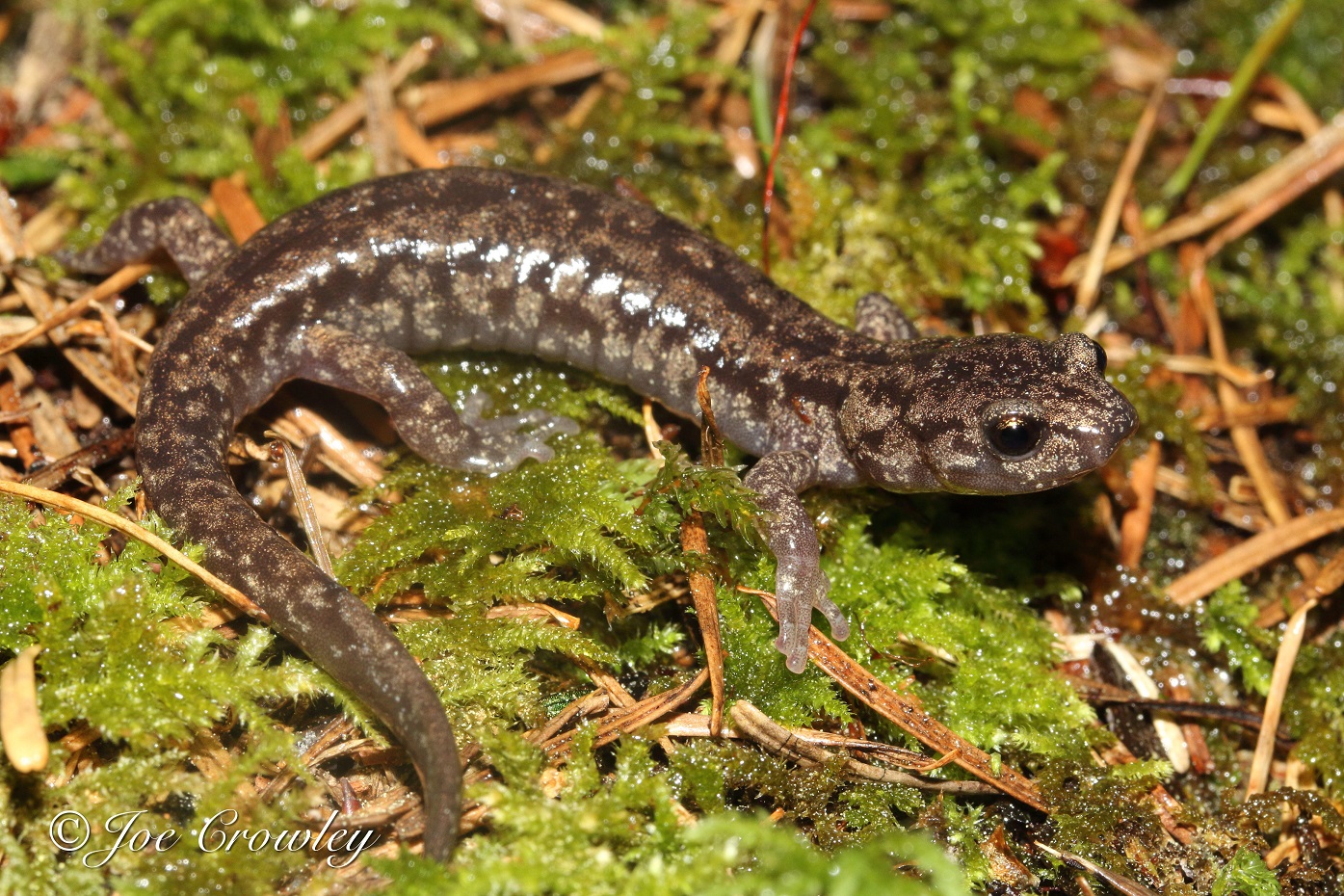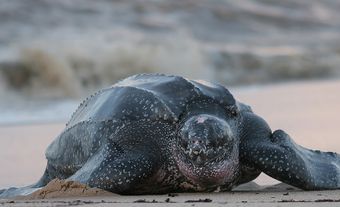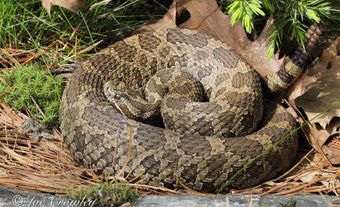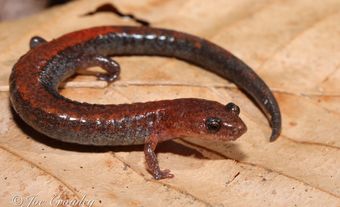Salamanders are tailed amphibians belonging to the order Caudata. There are around 800 known species worldwide; 22 are found in Canada. In addition to these species, the unisexual Ambystoma, a unique lineage of salamanders that does not conform to the typical definition of a species, are also found in Canada. Salamanders mainly live in the temperate regions of the Northern Hemisphere and tropical South and Central America. North America is home to more species of salamanders than anywhere else in the world. In Canada, salamanders are found from the Maritimes to British Columbia, and as far north as central Labrador and northern British Columbia; none have been recorded on the island of Newfoundland.

Salamander Species in Canada
|
Common Name |
Scientific Name |
Subspecies |
Provinces/Territories |
|
Allegheny mountain dusky salamander |
Desmognathus ochrophaeus |
ON, QC |
|
|
Blue-spotted salamander |
Ambystoma laterale |
MB, ON, QC, NB, NS, PEI, NL |
|
|
Coastal giant salamander |
Dicamptodon tenebrosus |
BC |
|
|
Coeur d'Alène salamander |
Plethodon idahoensis |
BC |
|
|
Eastern newt |
Notophthalmus viridescens |
Central newt (N. viridescens louisianensis), Red-spotted newt (N. viridescens viridescens) |
ON, QC, NB, NS, PEI |
|
Plethodon cinereus |
ON, QC, NB, NS, PEI |
||
|
Eastern tiger salamander |
Ambystoma tigrinum |
MB |
|
|
Ensatina |
Ensatina eschscholtzii |
Oregon ensatina (E. eschscholtzii oregonensis) |
BC |
|
Four-toed salamander |
Hemidactylium scutatum |
ON, QC, NB, NS |
|
|
Ambystoma jeffersonianum |
ON |
||
|
Long-toed salamander |
Ambystoma macrodactylum |
Eastern long-toed salamander (A. macrodactylum columbianum), Northern long-toed salamander (A. macrodactylum krausei), Western long-toed salamander (A. macrodactylum macrodactylum) |
BC, AB |
|
Mudpuppy |
Necturus maculosus |
MB, ON, QC |
|
|
Northern dusky salamander |
Desmognathus fuscus |
ON, QC, NB |
|
|
Northern two-lined salamander |
Eurycea bislineata |
ON, QC, NB, NL |
|
|
Northwestern salamander |
Ambystoma gracile |
BC |
|
|
Rough-skinned newt |
Taricha granulosa |
BC |
|
|
Small-mouthed salamander |
Ambystoma texanum |
ON |
|
|
Spotted salamander |
Ambystoma maculatum |
ON, QC, NB, NS, PEI |
|
|
Spring salamander |
Gyrinophilus porphyriticus |
Northern spring salamander (G. porphyriticus porphyriticus) |
QC |
|
Wandering salamander |
Aneides vagrans |
BC |
|
|
Western red-backed salamander |
Plethodon vehiculum |
BC |
|
|
Western tiger salamander |
Ambystoma mavortium |
Gray tiger salamander (A. mavortium diaboli), Blotched tiger salamander (A. mavortium melanostictum) |
BC, AB, SK, MB |
Description
Most salamanders resemble lizards and are sometimes erroneously mistaken for them. However, as amphibians, salamanders lack scales and claws and have moist, glandular skin. Lizards are reptiles and have claws and dry, scale-covered skin.
Most adult salamanders, including all of the species found in Canada, have four legs. However, some species elsewhere in the world have reduced legs or are missing hind legs altogether. Hence, salamanders differ from the limbless, tropical caecilians of the amphibian order Gymnophiona. Salamanders have tails and fine teeth on the upper and lower jaws. In this way they are different from the third group of amphibians, frogs, which lack tails (as adults) and lower teeth.
Salamander species vary in size from 3.9 cm to 180 cm. One of the largest salamanders in Canada is the 43 cm-long mudpuppy (Necturus maculosus); one of the smallest is the 5–9 cm-long four-toed salamander (Hemidactylium scutatum). The maximum lifespan of most Canadian species is around 10 years, but some species (e.g., mole salamanders and mudpuppies) may live for several decades.
Salamanders can sense vibrations but are unable to hear. They have two nostrils connected to the mouth, eyes that often have movable lids, a tongue that is often protrusible, a skeleton that is largely bony, and a three-chambered heart. They breathe through gills, lungs, the lining of their mouth, and their skin, sometimes in combination, sometimes separately. For example, members of the stream, spring, and woodland salamander family (Plethodontidae) lack lungs and breathe through their skin and mouth.
Like all amphibians, salamanders are ectotherms, meaning that they do not generate their own body heat. Instead, their body temperature is dependent on their environment. For example, amphibians can regulate their body temperature through behaviour and habitat use (e.g., by moving in and out of shade). This is known as “behavioural thermoregulation.”

Habitat and Behaviour
Salamanders have moist, porous skin, which makes them sensitive to dehydration. For this reason, they are typically found in water or other moist environments. Some species spend most or all of their life in water, including the mudpuppies (lakes), stream salamanders such as the dusky and two-lined salamanders (streams and creeks) and newts (wetlands). However, many species live on land during one or more of their life stages, and they are typically found in cool, damp habitats, such under leaf litter or rotten logs in forested areas. Terrestrial salamander species are unable to survive freezing temperatures and must hibernate during colder months. They spend the winter underground in burrows or other underground cavities where frost does not penetrate. Most aquatic species are probably active year-round. Most non-aquatic salamanders are active at night, usually during wet or damp periods; dry air and warm sun would quickly dehydrate them. During the early spring breeding season, mole salamanders (family Ambystoma) migrate across the landscape in large numbers as they move from their hibernation sites to their breeding habitat.
Reproduction
While salamander eggs may be fertilized externally or internally, all species living in Canada employ internal fertilization. When internal, the male deposits jellylike capsules of sperm and the female picks them up in the lips of the cloaca (i.e., the chamber through which eggs pass). The eggs are fertilized as they are expelled.
The number of eggs laid and the incubation period varies between species. The mudpuppy, which spends its entire life in water, lays its eggs under stones where they are guarded by the female. Adult and larvae red-spotted newts (Notophthalmus viridescens) live in water, but in most parts of their range the juveniles lose their gills, leave the water and spend a year or more on land. At this stage, they are referred to as “efts.” At maturity, they return to ponds to breed. Many of the lungless salamanders lay their eggs in moist terrestrial environments, such as sphagnum above woodland pools (e.g., four-toed salamander), or under rotted logs, stumps or other damp areas (e.g., redback, wandering and ensatina salamanders). The stream salamanders, which are part of the lungless salamander group, lay their eggs under stones in streams (e.g., two-lined and spring salamanders) and/or in nearby moist terrestrial habitats (e.g., dusky salamander). Mole salamanders (family Ambystomatidae) deposit eggs in temporary ponds in a jellylike mass attached to vegetation.
Some species lay their eggs in early spring, while others, such as the stream and woodland species, may not deposit eggs until summer. Water-hatching young breathe through gills and some species (e.g., coastal giant salamander) may retain these for several years before transforming into land-dwelling adults. Most adult salamanders in Canada are terrestrial, but some species have aquatic adults that retain their gills (e.g., mudpuppy). There are also species (e.g., coastal giant salamander and tiger salamander) that may either transform into terrestrial adults or, under certain environmental conditions, retain their larval gills after maturity and remain in the water.
Unisexual Ambystoma
The unisexual ambystoma are an all-female lineage of salamanders within the genus Ambystoma. They have unique mitochondrial DNA that set them apart from all other North American species of salamander. However, they require sperm from males of another Ambystoma species (e.g., blue-spotted or Jefferson salamander) to reproduce. The females often produce clones of themselves, but they sometimes incorporate the genetic material from the sperm of the species they breed with. As a result, the unisexual ambystoma are polyploid (having more than two sets of chromosomes) and visually resemble the other species they breed with.

Diet and Predation
All salamanders are carnivorous. Larger ones consume earthworms and adults and larvae of many insects. Smaller species eat small insects, insect larvae and various small invertebrates. Larvae eat tadpoles, smaller salamander larvae and aquatic invertebrates.
Fishes, frogs, snakes, turtles, birds and mammals are predators of salamanders. When caught, many salamanders are able to break off their tails. The tail continues to twitch for a short time, allowing the salamander to escape as the pursuer is decoyed into seizing the tail. Salamanders are able to regenerate the tail, but the regenerated part is usually shorter than the original. Most species have mildly poisonous glands in the skin that can cause irritation to some animals.
Biological Importance
Salamanders can be abundant in terrestrial and aquatic habitats and play important roles in their ecosystems. Larve are primary consumers in aquatic food chains and are an important source of food for various invertebrates and vertebrates. Adult salamanders are also important predators of invertebrates, as well as some smaller vertebrate species. They are in turn consumed by a wide range of other species, such as fish, birds, reptiles and mammals. With many species having both terrestrial and aquatic life stages, salamanders play an important role in the movement of nutrients between these different environments. Salamanders are probably also beneficial to the forestry and agriculture industry as they consume injurious insect pests.
Salamanders, which have an uncanny ability to regrow their limbs, have considerable value as study organisms for scientific and medical research into tissue and limb regeneration. Several species of salamanders are considered at risk in Canada because their populations are small and/or experiencing declines due to a variety of threats. Species that are listed as threatened or endangered under Canada’s Species at Risk Act receive legal protection. (See also Endangered Animals in Canada.) Because of their abundance, sensitivity to environmental change, and important ecological roles in forest ecosystems, biologists often use salamanders as indicators of forest health. If salamander populations are stable and thriving, then this can indicate that the forest ecosystem is healthy.

 Share on Facebook
Share on Facebook Share on X
Share on X Share by Email
Share by Email Share on Google Classroom
Share on Google Classroom





